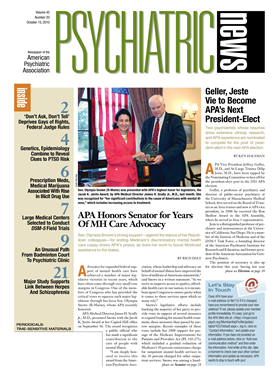New York state's aggressive funding of its outpatient civil-commitment program since it was launched in 1999 sets the state apart from the level-funding approach most other states have used when launching similar initiatives.
New research indicates that the generous funding has led to expanded treatment for people with mental illness in the criminal justice system, without reducing treatment availability in other parts of the state's public mental health system, as critics feared would occur.
Results of an examination of New York state's assisted outpatient treatment (AOT) program, published in the October Psychiatric Services, found that the program did not disadvantage voluntary mental health treatment recipients by focusing resources on patients ordered to treatment by the courts.
The study authors, led by Jeffrey Swanson, Ph.D., of the Psychiatry and Behavioral Sciences Department at Duke University School of Medicine, examined state administrative data from 1999 through 2007 to gauge the impact of the law, known as Kendra's Law. It allows court-ordered AOT for people with severe mental illness who have been noncompliant with treatment and as a result have been arrested or hospitalized.
After comparing trends in the use of enhanced outpatient services by both involuntary and voluntary treatment recipients with severe mental illness, the researchers found that most of the new $125 million in funding that the state initially allocated went to people under court-ordered treatment. However, treatment provided to both involuntary and voluntary patients “expanded steadily.”
“In the short run, services to individuals who were not under AOT may have been delayed, or some individuals may have been displaced from services by the influx of new court-ordered persons in the system of care,” said Swanson and colleagues. “However, the findings of this study suggest that in the long run AOT is a program that came bearing new services and has left in its wake a system of care with greater capacity to serve all persons with serious mental illness, voluntary patients no less than involuntary ones.”
It's a finding that New York psychiatrists who have worked with the AOT program endorse.
“For the people it serves, [AOT] does a very good job,” said Steven Hoge, M.D., former director of the Division of Forensic Psychiatry at Bellevue Hospital at New York University School of Medicine.
Additionally, Hoge told Psychiatric News that “protected funding has been very useful” in maintaining robust AOT programs. In fact, he added, at least three times as many people with severe mental illness in New York also could benefit from the program if funding were expanded further.
Gary Collins, M.D., director of the NYU/Bellevue Hospital Center AOT Program, told Psychiatric News that he has seen similarly beneficial clinical outcomes.
However, Collins cautioned that research has yet to demonstrate a causal relationship between AOT and the clinical outcomes, and more comprehensive research on the New York AOT program is needed.
Hoge agreed that some data offered by the state on the long-term efficacy of the program are limited, because the state compares one-year pre-AOT patient outcomes with their outcomes for only the first six months after leaving AOT. Other research has indicated that clinical outcomes—other than propensities for violence—begin to deteriorate to their pre-AOT levels more than a year after leaving an AOT program.
The positive violence-prevention-related results from the AOT program led the New York legislature to approve a five-year extension of the program this past summer after mental health advocates campaigned for the program's renewal (Psychiatric News, June 4).
“A majority of states that have court-mandated outpatient treatment programs legislated them but did not adequately fund them, and subsequently [they] are very highly underutilized,” Collins said. So New York's decision to provide substantial funding for its program “has been one of the reasons that there has been significantly higher enrollment in New York state's AOT program.”
Similar AOT programs in other states have struggled because of a lack of additional funding, including a law to expand outpatient civil commitment in New Jersey that Gov. Chris Christie (R) put on hold this summer because no new funding was allocated to implement it (Psychiatric News, September 17).
However, the New York program has begun to show signs of strain after more than 10 years.
For instance, some of New York's AOT services have had trouble recruiting psychiatrists in recent years, Hoge said, because funding hasn't allowed salaries to keep up with inflation. Additionally, many private and some public hospitals do not participate in the AOT program because it can take up to 60 days to obtain the necessary court order for continuing treatment, and the facilities don't want to bear the uncompensated costs of holding and treating the patient for that time or the legal costs to obtain an AOT order.
Another ongoing challenge for AOT programs is that they are not the universal solution some politicians may believe them to be, because their effectiveness is predicated on at least some amount of “patient buy in.”
“In part, it requires someone to accept the fact that they are going to be ordered to treatment that they would prefer not to take, but if someone is going to tell them they have to take it, then they'll comply,” Hoge said. “It certainly seems to apply to a fair number of patients whose treatment courses have been problematic.”
The practical limits of the AOT program were evident when officials tried to institute an AOT program for inmates leaving Rikers Island prison. That inmate population frequently dropped out of the program, and many were unable to be located again.
